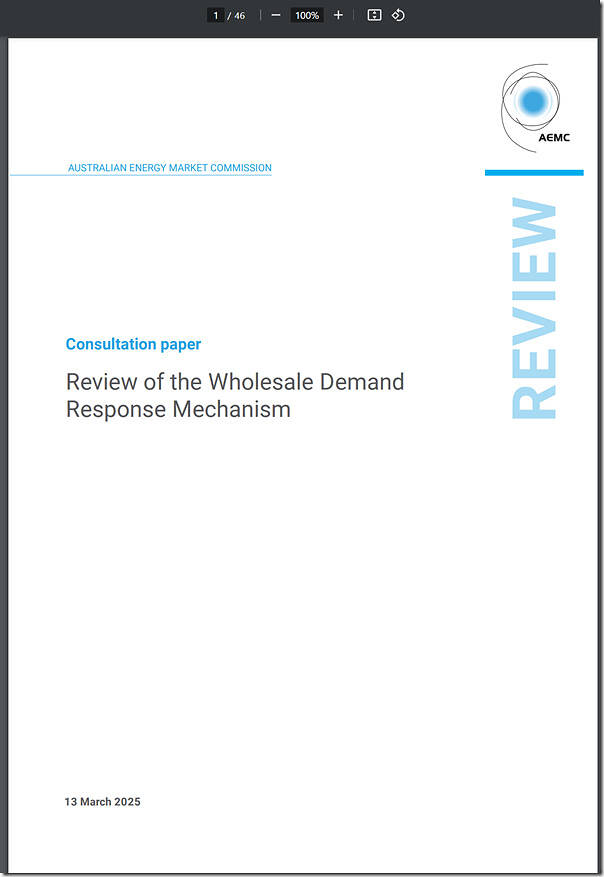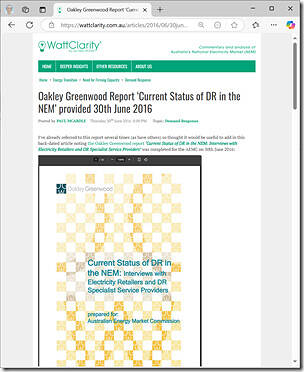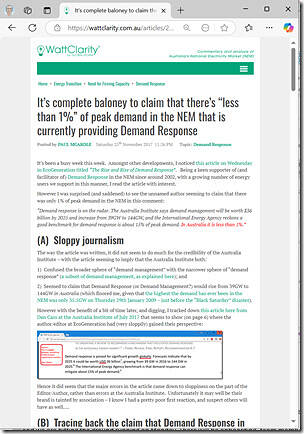One other (relatively) recent activity at the AEMC we thought was worth noting is that on 13th March 2025 in this Media Release, the ’AEMC launches review of the wholesale demand response mechanism’.
This notes:
‘The Australian Energy Market Commission (AEMC) has initiated a review into the wholesale demand response mechanism (WDRM), with the release of a consultation paper today, as required under the National Electricity Rules.
The WDRM, which commenced operation in October 2021, aims to enhance the flexibility and reliability of the National Electricity Market (NEM) by allowing demand response to bid directly into the wholesale market as a substitute for generation.’
… and …
‘To explore these issues, the AEMC is asking for submissions on the consultation paper by Thursday 24 April 2025.’
That date for submissions has already elapsed, but perhaps this article will provide useful food for the AEMC (and broader industry) consideration in the coming weeks.
It might be the case that this AEMC review is discussed at this week’s 2025 EUAA National Conference in Melbourne. Might see you there?
AEMC Consultation Paper
Further details are provided on the EPR0099 Market Reviews sub-site, including this Consultation Paper:
We thought it was worth copying out of this Consultation Paper the following snippets, with our emphasis added (from p3/46):
‘The WDRM was established through a rule made on 11 June 2020 and commenced operation in the national electricity market (NEM) on 24 October 2021. The WDRM allows demand response service providers (DRSP) to offer demand response into the NEM, where it can be dispatched and paid in the same way as generators.’
… and …
‘To date, there has been limited participation in the WDRM compared to expectations* in the 2020 final determination; two DRSPs have registered a combined 74 MW of response across 20 wholesale demand response units (WDRUs), which have been dispatched for 1,258 MWh of response.
In establishing the WDRM, the Commission considered that if there was to be a move to a two-sided market in the future then this move should replace the WDRM. A two-sided market is characterised by the active participation of the supply and demand side in dispatch and price setting.’
Part of the purpose of (and linkage in) this review was the AEMC Final Determination in ‘Integrating price-responsive resources into the NEM’ (a.k.a. ‘Schedule Lite’) from December 2024.
Hang on! … what was actually expected from the WDRM (and by whom)?
We think it’s quite important to highlight the statement ‘there has been limited participation in the WDRM compared to expectations*’ …. because it does not tell the whole story, (and indeed might reveal a whole lot more than the authors intended) because:
- Whilst it might have been the case that the stated expectation in the 2020 final determination might have been for more glowing successes
- It is our sense that
- such a ‘rose coloured glasses view’ was informed by some very optimistic thinking,
- and very keen lobbying by some parties (including some journalists who’d perhaps drunk a bit too much of the Kool Aid promoted by the boosters?);
- There were plenty of stakeholders (us included) who expected the change to be a waste and a distraction, which (it’s our sense that) is exactly what has come to fruition.
I remain hopeful that this time the AEMC reflects on why their earlier expectations turned out to be wildly optimistic?
Reflecting on prior commentary here on WattClarity?
Back in January 2019 on one of our other sites we wrote about:
- Both ‘Some highlights on our Demand Response journey (to 31 Dec 2018)’ on 3rd January 2019; and also
- ‘Real Barriers we’ve experienced in the growth of Demand Response in the NEM’ on 7th January 2019.
As noted in those articles (i.e. Global-Roam Pty Ltd) have been a keen supporter of a different form of Demand Response for what’s now 20 years or more (those who want to understand what we do more broadly can check out this 25-year review).
- That other form of Demand Response has proved to be quite beneficial to a number of large industrial energy users (and to some extent the grid, indirectly) for many years;
- Though we have more recently been puzzled about how the currently chosen energy transition** path could be presenting increasing challenges*** to that long-standing method of Demand Response.
** Many people see the transition from ‘Baseload + Peaking’ to ‘VRE + Firming’ … but perhaps it’s more accurate in thinking that we’re moving towards a combination of:
(a) ‘Anytime/Anywhere Energy’ and
(b) ‘Keeping the Lights on Services’ (i.e. it’s much more than ‘Firming’ of Energy)
*** For those attending the upcoming EUAA National Conference (Wed 7th & Thu 8th May 2025) in Melbourne, we might start some more exploration there!
Here on WattClarity® we’ve written many articles about the ins and outs of Demand Response (more broadly), as we see it, and also about the several moves to implement a Centralised Negawatt Dispatch Mechanism in the past…
Key Dates |
Quick Summary |
|---|---|
December 2002 |
Way back in December 2002 we saw the release of ‘The Parer Review’ … which, following a prior request from Tim Nelson, we dug out of our archives and made available in the article: ‘The Parer Review (December 2002) – Towards a truly national and efficient energy market’ From p178/290 of the Final Report was Recommendations relating to ‘Demand side participation and full retail contestability in electricity’ … which included a proposal (p178/290) to ‘Introduce a demand reduction bidding system into the NEM.’ We’ll leave readers to venture back through that ancient history, if they want…. |
January 2007 |
The next major review (that we can recall) was ‘the ERIG Review’ which we belatedly documented in the article: ‘The ERIG Review ‘Energy Reform: The way forward for Australia’’ The Full Report contained a section (p251/303) about ‘Demand response’ that contains findings and recommendations (p256) that includes the following two notes: ‘In the large customer segment, while progress has been only fair, there seems to be little basis for a policy response.’ … and … ‘ERIG recommends that the MCE develop a strategy for automation of DSM suitable for application to small customers; and review the institutional arrangements to ensure that participants can capture the benefits of DSM and drive the DSM development process. ’ … which, we note, is the type of activity undertaken by participants such as Amber Electric and others. |
30th June 2016 |
On 30th June 2016 Oakley Greenwood provided their report ‘Current Status of DR in the NEM: Interviews with Electricity Retailers and DR Specialist Service Providers’ to the AEMC:
Worth noting this, individually, as it was referenced in some of what follows…. and down a particular rabbit hole many fell. |
24th Nov 2016 |
On 24th November 2016 the AEMC: (b) … that led to the establishment of (unbundled) Demand Response as a type of service eligible to bid into FCAS markets (c) which came into effect in mid 2017: i. It was to be 1st July 2017 ii. But for some reason my sense is 29th August 2017 was also a significant date. See this category here on WattClarity for more details… |
1st June 2017 |
The Finkel Review was published on 1st June 2017, as noted on WattClarity. In the Final Report we note that Chapter 6 was titled ‘Rewarding Consumers’ (p137), that included Recommendation 6.7 (p152) as follows: ‘Recommendation 6.7 The COAG Energy Council should direct the Australian Energy Market Commission to undertake a review to recommend a mechanism that facilitates demand response in the wholesale energy market. This review should be completed by mid-2018 and include a draft rule change proposal for consideration by the COAG Energy Council.’ It’s important to note that (in forming this view) the Finkel Report referenced heavily the Oakley Greenwood report of 30th June 2016 prepared for the AEMC (that’s explicitly called out above).
|
25th November 2017 |
Worth explicitly calling out a criticism we’d published on 25th Nov 2017 titled ‘It’s complete baloney to claim that there’s “less than 1%” of peak demand in the NEM that is currently providing Demand Response’ in response to (what we saw as) pretty sloppy journalism:
|
15th November 2018 |
In 2018 the AEMC commenced another round of consideration of the establishment of a ‘Centralised Negawatt Dispatch Mechanism’ (our name for this) following from separate rule change proposals submitted:
The AEMC wrapped established the sub-site for Project ERC0247 to collate the relevant documentation. A consultation was published on 15th November 2018 to formally commence the process. … further details below |
2019 and 2020Our concerns, through the AEMC’s deliberation process |
We raised concerns about proceeding down this path in several articles – in our view at the time, it was not going to be sustainable or scalable in the coming years. Some articles raising these concerns include: 1) On 5th March 2019 I wrote about ’Some thoughts about Demand Response, in parallel with AEMC deliberations’ at the commencement of the AEMC’s processes. 2) On Monday 21st October 2019 I followed that up with ‘All aboard the Negawatt Express … but where are we really headed?’ following the AEMC’s draft determination. 3) On 5th May 2020 some concerns were also raised when discussing ‘Balancing Supply and Demand …. in the fast approaching ‘NEM 2.0’ world’ about some broader challenges of the energy transition using data from GSD2019 (analysis we updated in GenInsights21) 4) On 10th June 2020 I posted about ‘The rise of the ‘Negawatt Factory’?’ in conjunction with the AEMC’s Final Determination. 5) On 24th November 2020 with the rise of negative prices I posted about ‘Making demand response work with negative prices’ – because the way the WDRM works, doesn’t do anything to assist that rapidly growing issue (or opportunity). … plus others But not sure they were receptively read? |
11th June 2020 |
AEMC releases Final Determination, to establish the WDRM Following from all of the above, on 11 June 2020, the AEMC released a final rule and final determination to implement the wholesale demand response mechanism (WDRM). |
On 24th Oct 2021 |
WDRM commences On Sunday 24th October 2021 the WDRM went live. On WattClarity:
|
Since 24th Oct 2021 |
Since that time, we’ve continued to publish articles about this new 1) with respect to a longitudinal view: (a) via ‘Wholesale Demand Response in the NEM – One year on by the numbers’; and then (b) and then ‘Demand Response as Market Participant: Square Peg in Round Hole?’ after the second year. (c) but we could not even summon the interest to take another look in Oct 2024 (after 3 years) 2) But also about the specific incidents: (a) In QLD on 1st and 2nd February 2022, in amongst volatility (b) With respect to 13th June 2022 in the midst of the energy crisis; and … plus more in here, and … (c) With a quick review of 22nd Jan 2025 in QLD we saw that ‘the ‘Availability’ of registered Negawatts was only 20% as well ‘. (d) There was nothing to see here on 12th February 2025 in South Australia. (e) As recently as ‘nary a negawatt, for QLD and NSW’ during an April 2025 week that saw evening volatility. So readers need to keep in mind that, even below the (already low) registered capacity base, the actual volume offered and deemed to be delivered through these periods was much lower still. Pretty lacklustre, really…
|
by 24th October 2025 |
So we come to this AEMC Review. This (delayed review) was flagged in the Media Release on 30th May 2024 ‘AEMC’s review of the Wholesale Demand Response Mechanism’, which stated: ‘The Australian Energy Market Commission (AEMC) will conduct and complete its review of the Wholesale Demand Response Mechanism (WDRM) by 24 October 2025, to allow time to properly investigate “two-sided” market options proposed in closely related reforms.’ This date being a 12 month delay on the AEMC’s own (earlier established) deadline for the review… ‘This delay will result in the Commission breaching its rules requirement to complete this review by October 2024. The AEMC has deemed this necessary, given the impact these rule changes may have on the direction of the review. To commence the review in advance of these rule changes would likely lead to an incomplete consideration of how best to integrate demand response into the NEM. ’ So we might now hear more, by 24th October 2025 (i.e. 4 years on from the commencement of the WDRM). |
End-of-2025 |
For fullness, worth also noting that the Nelson Review is running in parallel to these AEMC deliberations. Let’s hope they don’t trip over each other… |
The articles linked above might be useful context, to those who want to venture down that rabbit hole.





Those pesky Negawatts !!